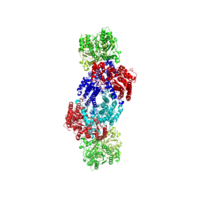
Photo from wikipedia
The roles of unforgiving H2SO4 solvent in CH4 activation with molecular catalysts have not been experimentally well-illustrated despite computational predictions. Here, we provide experimental evidence that metal-bound bisulfate ligand introduced… Click to show full abstract
The roles of unforgiving H2SO4 solvent in CH4 activation with molecular catalysts have not been experimentally well-illustrated despite computational predictions. Here, we provide experimental evidence that metal-bound bisulfate ligand introduced by H2SO4 solvent is redox-active in vanadium-based electrocatalytic CH4 activation discovered recently. Replacing one of the two terminal bisulfate ligands with redox-inert dihydrogen phosphate in the pre-catalyst vanadium (V)-oxo dimer completely quenches its activity towards CH4, which may inspire environmentally benign catalysis with minimal use of H2SO4.
Journal Title: Chemical communications
Year Published: 2022
Link to full text (if available)
Share on Social Media: Sign Up to like & get
recommendations!